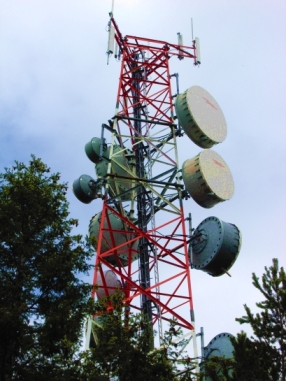Heidi Collins: A Rolling Refugium
By Kim Goldberg
December 21, 2013
At age 65, Heidi Collins has slept in her car nearly every night for the past twelve years. This is the only way she has found to escape the excruciating pain and inflammation caused by wireless transmissions from cell towers and from the wireless devices of her neighbours.
So precarious is Heidi’s existence, leaving her vulnerable to all manner of harassment and predation, that she has asked me not to reveal her real name or face, or even the city she has been living in, or the part of the country she is now headed for.
“I have to find those rare spots where I don’t get the pain,” Heidi says of her nightly search for safety in a densely populated tourist destination on the Florida coast. “And I often change my location more than once in the middle of the night. Sometimes I have to drive for three or four hours to find a pain-free spot. Things have gotten progressively worse each year, so I have to keep moving farther away from the downtown area each night.”
It’s a crazy way for anyone to live. But Heidi is far from crazy. She is sane, articulate, and well educated with more than six years of college. In earlier years, Heidi worked in the forest service and on an international wildlife film festival, among other jobs. She dreamed of becoming a wildlife researcher or photographer in Africa—all part of her lifelong love of nature and the outdoors, she tells me.
However, Heidi has an extreme case of Electromagnetic Hypersensitivity (EHS). The condition has scuttled many of her dreams and aspirations, and has, in recent years, left her scrambling to simply survive each day.
The challenge of juggling both an apartment in a big city and seeking nightly refuge in her car finally grew too large to manage on her monthly Social Security check.
“I could not afford both rent and the huge amount of gas I was using each night just to find a pain-free place to sleep,” she explains. “I was living from check to check with no savings and no ability to work. So I had to move out of my apartment.”
Heidi managed to purchase a van and is finally poised to leave Florida this month. She is heading to some rural mountains in another state with no plan to return.
“I’m moving at the worst time of year with nowhere to stay but my van,” she tells me a few days before departing. “It worries me, but I must leave.”
Heidi’s extreme EHS may be compounded by Lyme Disease—an illness she believes she contracted in 1991 when she found a huge array of ticks on her body during a 17-day event in a national forest. And indeed, some of Heidi’s most severe EHS symptoms (such as collapsing on the ground when exposed to microwave ovens) are typical of Lyme sufferers with EHS because of the neurological degradation and demyelination caused by Lyme Disease.
Another contributing factor to Heidi’s electrosensitivity may be her exposure 15 years ago to the insecticide malathion when crop-spraying airplanes ventured off-course and over her residential neighborhood during a moonless night. (There is some evidence suggesting a correlation between chemical poisoning and heightened electrosensitivity.)
Heidi experienced severe burning where the falling chemical touched her skin as she ran to her car to drive away. And she later lost most of the vision in her left eye. Authorities told her to throw away any clothes that had come in contact with the chemical. But one can’t throw away one’s body. Heidi joined a class action lawsuit along with 250 people who had been injured by the spraying. The lawsuit stalled out after a few years.
Heidi had her first episode with electrosensitivity in 1997, shortly before her exposure to the malathion.
“I felt like all the nerve connections in my brain had been pulled apart.”
“I was staying with someone for the weekend,” she recalls. “I was feeling good that day and was in the bathroom when all of a sudden this terrible dizzy feeling came over my brain, and I went down on the floor. I couldn’t get up off the floor for two hours. It felt like all the nerve connections in my brain had been pulled apart. My friend talked to me through the door, and he told me he had just turned on and off a brand new, very large microwave oven that was eight feet away from the bathroom.”
In subsequent years, Heidi’s reaction when exposed to wireless radiation has expanded to about twenty different symptoms including: a burning in her head and upper spine, a feeling of being “stabbed in the skull with an awl”, tightness across the chest that constricts her breathing, rapid swelling of lymph nodes in the armpits and neck, heart arrhythmia, and a nausea that “comes out of nowhere so fast I could vomit out a car door,” she says.

Heidi’s love of nature has been an enduring source of joy in her life while coping with the daily struggle to survive in our electrified world. (Photo © Kim Goldberg)
“When I am stopped at a red light next to a cell phone tower, the lymph nodes and glands in my neck will sometimes swell immediately and grossly,” she adds.
But microwave ovens provoke the worst response in her, and for long after they are shut off. Heidi believes this is evidence that wireless radiation—even if brief in duration—is triggering an inflammatory reaction in her body.
“I experience chest tightness and difficulty getting air for up to four hours [after exposure], until the swelling goes away,” she explains. And she must now distance herself at least seventy-five feet from a microwave oven that is on for more than a few seconds or she will succumb to its effects. (By comparison, her “safe” distance from a cell phone in use is twenty feet, and from a wireless laptop, ten feet.)
Her sensitivity has recently expanded to include anti-theft gates at store entrances and exits. “It felt like a hard punch to the heart,” she says of her experience upon passing through these gates (which involve a wireless radio frequency sweep of everyone and everything passing between the two posts). “I was flat out for three days after that, as though I’d had a heart attack, even though I have no known heart problems.”
Remarking on the terminology itself for EHS, Heidi says ‘sensitivity’ is far too light a word to describe it. “It’s more like a severe allergic, life-threatening response if one cannot get away from the cause of it,” she explains.
Heidi spent three months in Brazil at the Casa de Dom Inacio, hoping to be healed. Back home, she has purchased various ‘cures’ including pendants, a Teslar watch, and a waist-worn device for counteracting electromagnetic radiation—all to no avail. Her only successful treatment protocol to date has been climbing into her car each night and driving until she finds a pain-free location.
In her inflamed and swollen condition, her body instantly tells her when she has arrived at a safe spot. “I feel like a blown-up balloon that’s just been pricked, and all the air is starting to come out while I deflate and feel increasing relief,” she explains.
Heidi talks about being doubly vulnerable and at risk, both as a single woman travelling alone and sleeping in her vehicle, and as a person with a life-threatening condition that is disbelieved and even mocked by many people she encounters.
“There are people who will intentionally harm you if they know your weakness,” Heidi explains. “They will hold cell phones in your face or put on their microwave oven without telling you. I was naïve when I first got this and I told my neighbors. Two of them decided they’d run their microwave ovens as often as they could when I was home,” she recounts.
“Far more is invisible than visible.”
“Even well-educated people and friends can be extreme skeptics, believing only in the visible and tangible manifestations of our reality,” Heidi continues. “Yet they must know microwave radiation is real because without it, their cell phones would not work! Far more is invisible than visible.”
We talk about the isolation electrosensitive people live with: “I can almost never relax around others. I can’t sit in restaurants, Starbucks, bars. I have to eat in my car by myself or constantly be changing my seat, appearing crazy to others,” she describes.
We talk about the logistics of living and sleeping in a vehicle: “I can’t just go to the middle of nowhere,” she explains. “I need to have some place to buy healthy food nearby, and somewhere to get online [without WiFi], since the Internet is my only means of communicating with people. It takes me approximately four hours each morning just to get clean, switch out the ice for my coolers, buy some groceries for my breakfast, and go to restaurants for that day’s meals as take-out—what I call my survival chores.”
“Treated like a criminal, forced to live like a fugitive.”
We talk about how people and authorities react to someone sleeping in a car: “I am treated like a criminal and forced to live like a fugitive,” she says. “It’s a jailable offence to sleep in one’s car within the city limits of my town,” she adds. One night when she was awakened by a police officer pounding on her car window and telling her to leave the parking lot, she replied, exhausted and groggy: “Is it illegal for me to try to stay alive?”

Like many electrosensitives, Heidi is drawn to water – perhaps because the negative ions associated with water help discharge electromagnetic radiation from the body. (Photo © Kim Goldberg)
We talk about what it will take for the world to wake up: “I think eventually we’ll see we are killing off the planet through microwave radiation,” she predicts, “whether through the number of people dying very early from cancers caused by it, or the loss of honeybees, birds, trees, whales and more.”
We talk about where she finds joy amid the struggle of her daily existence: In nature, playing folk music with other people, reading up on metaphysical topics, spiritual teachings, ancient civilizations. And water. “I love anything to do with water,” she tells me. “I seek water when I want to be at peace.” (This affinity for water is, in fact, a common trait among the electrosensitive people I have been meeting and interviewing. And there is no question that the negative ion field associated with water helps discharge electromagnetic radiation from the body.)
We talk about books, publishing, freelance writing. She says she would like to tell her story someday in a book of her own. I encourage her to do so, saying I’ve supported myself as a freelance writer for three decades. She says she would like to do that too. “I’m 65 now and just getting started again,” she remarks, “as if I’m in my twenties!”
But survival comes first. So for the time being, Heidi is living in her rolling refugium, headed to points unknown but in the general direction of some sparsely populated mountains—and contemplating her book.
Text and images © Kim Goldberg 2013. All rights reserved.
(Heidi Collins’ story will be included in Kim Goldberg’s forthcoming book REFUGIUM: Wi-Fi Exiles and the Coming Electroplague, due out in 2014. Read more people’s stories here.)




No comments:
Post a Comment